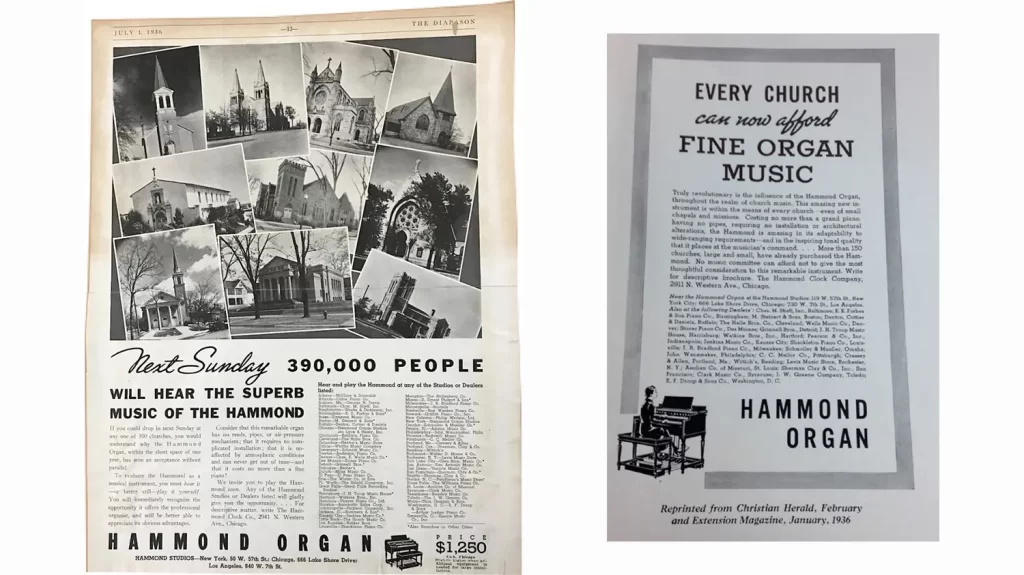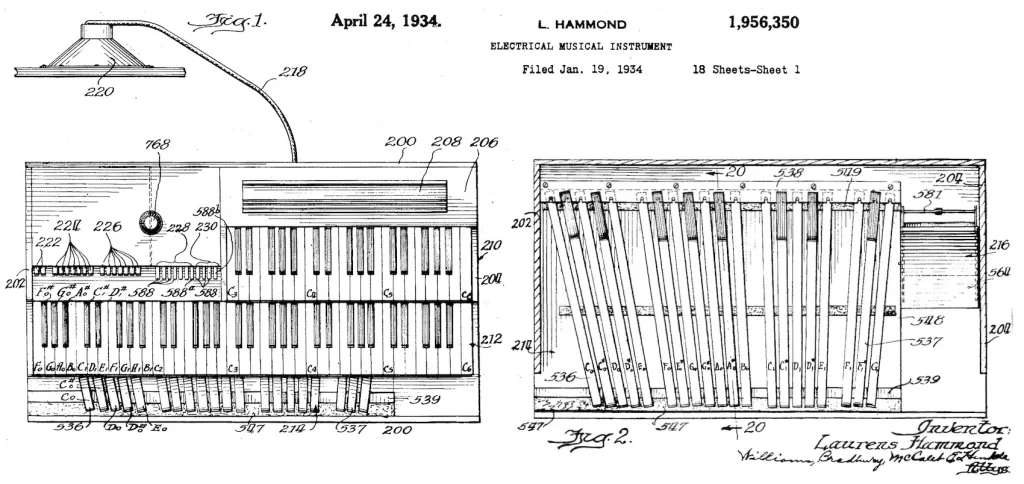As highlighted at the end of part one of this series, events of the late 1920s and early 1930s nearly forced Laurens Hammond to close The Hammond Clock Company. The invention and sales of the Hammond Electric Bridge Table bought Hammond enough time to fully develop his most important invention: The Hammond Organ.
The Hammond Organ
In an unpublished biography, entitled Hammond As In Organ: The Laurens Hammond Story, by Stuyvesant Barry, Hammond outlined the process that led to the creation of the organ:
I used to make up lists of things that were basic ideas that I might develop…The smart thing for an inventor to do is to put together the old tricks you have done before, and one of the things I listed was something that could use a tremendous lot of these little motors we used in clocks. Then I thought of the dictum that anything that can be an electric motor can also be a generator- if you just took a Hammond clock and turned its wheels, you could generate electricity – and this electric current could be used to produce sound.
Any note in the musical scale represents a fixed number of vibrations per second. The A note, for example, represents the sound that results from 440 vibrations per second. Synchronous motors, a device with which Hammond was intimately familiar, operate at the same speed indefinitely if they received a constant, stable frequency of power. Hammond utilized these principles in developing the tonewheel, which is the apparatus that generates the sound inside of a Hammond Organ. Ultimately, the tonewheel works by manipulating the frequency of a synchronous motor and translating the result into corresponding sounds.
In 1933, Hammond gutted a second-hand piano and combined the keyboard with a tonewheel, and the rest is history. In 1934, after perfecting the design, Hammond filed a patent for an”electrical musical instrument.” Hammond was able to streamline the patent process by personally delivering all the documents to the patent office and making the argument that he could immediately put hundreds of Chicagoans to work – Chicago being the main Hammond Clock Company headquarters. As the country was still very much in the grips of the Great Depression, the argument was persuasive, and the Hammond Model A Organ hit the market in early 1935, and immediately took the world by storm. The immediate success led to The Hammond Clock Company changing its name to The Hammond Organ Company.
FTC Complaint Against The Hammond Organ Company
In the first three years of operation, more than 1,750 churches had purchased a Hammond Organ. However, in 1937, the Pipe Organ Manufacturers Association filed a complaint against The Hammond Organ Company with the Federal Trade Commission (FTC). The complaint took issue with a wide variety of claims made in Hammond Organ advertising. Specifically, the Pipe Organ Manufacturers Association argued that the claim that the Hammond Organ could reproduce “the entire range of musical tone colors” and that it had a “range in harmonics” equal to a pipe organ were false and misleading. This complaint led to a ridiculous series of events that would make a good movie or show.
Hammond, seizing on the FTC complaint as an excellent opportunity for advertising the quality of his products, organized a series of demonstrations that culminated in a trial of sorts between a roughly $2,600 Hammond Organ against a $75,000 Skinner Pipe Organ. The trial, which took place at the University of Chicago’s Rockefeller Chapel, gathered two juries – one of professional musicians, and one of student volunteers. The two juries were asked to listen to thirty selections of music, which were played on either the Hammond Organ or the Skinner pipe organ at random. The jurors were asked to choose which organ selections played each selection of music. The students selected the right answer roughly half of the time, but the professional musicians were all across the board, ranging from choosing 10% to 90% correctly.
Ultimately, in 1938 the FTC ruled that the Hammond Organ Company had to remove a few claims from their marketing material including claims that a Hammond was equivalent to a $10,000 pipe organ, and that the term “infinite tones” had to be removed. Ever the optimist, Hammond claimed that the hearings had vindicated his company’s assertions that the organ produced “real”, “fine”, and “beautiful” music, phrases which were each cited in the FTC’s original complaint, but not included in the final judgment.
Whatever the case, the Hammond Organ continued to be a massive success. By the end of the 1930s, roughly 200 Hammond Organs were being manufactured each month, which hardly kept up with the demand. By 1966, it was estimated that roughly 50,000 churches across the U.S. had installed a Hammond Organ of some kind. By the time of its sale to the Suzuki Musical Instrument Corporation in 1985, The Hammond Organ Company had produced and sold more than two million organs. While the Hammond Organ was eventually adopted by a wide range of professional musicians, the original Hammond Organ Company never targeted that market and focused almost entirely on the church organ market.
up with the demand. By 1966, it was estimated that roughly 50,000 churches across the U.S. had installed a Hammond Organ of some kind. By the time of its sale to the Suzuki Musical Instrument Corporation in 1985, The Hammond Organ Company had produced and sold more than two million organs. While the Hammond Organ was eventually adopted by a wide range of professional musicians, the original Hammond Organ Company never targeted that market and focused almost entirely on the church organ market.
Through all of the success, however, Hammond had a profound dislike of both Donald Leslie and his product which has become nearly as iconic as the organ: the Leslie Speaker.









Y haven’t Hollywood made
A
Movie about this?
I have been playing a Hammond B3 for nearly 50 years in churches tents auditoriums rock groups country groups etc. it is the best organ ever made
I’m a Hammond technician in St Louis, an early hotbed for Hammonds. And even Hammond clocks are pretty common here. Laurens had a great idea, but it’s a shame he didn’t like Leslie… it was because of the popularity of the Leslie cabinets that he rewired his organs to prevent Leslie from making speakers for them, which Leslie overcame in mere days… but that several people were electrocuted trying to hook them up!
HAMMOND IS LIKELY THE ONLY Pre~85′ Company in the WORLD that hadn’t SOLD OUT.
The Products That WE’RE MADE IN THE USA HAVE ARE SIMPLY UNMATCHED,
HAMMOND, “THANK YOU” for giving me the life I would never have known.
60 years ago my Parents bought me a brand new B3 even though we were not rich and it’s been the best feeling l could ever imagine.
All Players know that FEELING!!!
MONTEblu
I have a perfect condition Hammond B3, with speaker, for sale in the Seattle area. Unique dark green and black wood. Ps23126 at yahoo dot com
No offense, but Japanese have tried to duplicate the Hammond organ. The New XB3 is trash and it doesn’t last long before it needs service. The Hammond organ was built to last a lifetime. I have a B3 and I love it. Been playing organ for 30+ years. Nothing like it.
I grew up being taught on the Hammond Organ. I couldn’t imagine playing without the Leslie speakers. Ironic they never really partnered to make it happened. But it happened inspite of personal dislikes. Wonderful instrument. Nord is trying to come close but I would still prefer the Hammond organ
I love the Hammond sound but because they are so expensive, I found the Ferrofish B4000+ with all the same effects and Leslie and drawbars, It has been and still is an awesome organ midi device I use daily with my synthesizer keyboards, but more affordable and more mobile to use on my gigs
I could never afford a B-3. I’ve played an M-3 for almost 40 years and Love it! It may be a spinet, but still a very fine instrument! Easier to move to a gig, too. 🙂
I have owned a B-3 since 1969,I purchased it in Pennsylvania. The first time I heard one play was at a concert with Jr. Walker. I had to have one.
I never knew that it originated from a clock company from Chicago. Great history. I was aware of the Hammond and Leslie conflict. Hammond did have a Tone Cabinet which was OK, until Rock hit the scene and the Leslie 147-122 were used. Got to see Jimmy Smith, one of my idols play live and recorded with the 147…
Today they are trying like hell to duplicate the Hammond Leslie sound, not going to happen!! I just added the Trek 2 system, which gives my B-3 even more kick. What a cool instrument, and the most and best sound ever invented.
I love telling other musicians I play the B, they are amazed that I own a vintage instrument.
Justin
No mention of Jim Hanerts S-6 Chord organ development for Hammond. I have a 1956 S-6 that I’ve been playing since 1972.
It supposedly saved Hammond in the 50’s.
I keep it and a 147 in a trailer outside. 10 or 15 degrees below zero. I bring it in wherever I’m playing and plug it in and it works. Not to mention the bouncing trailer.